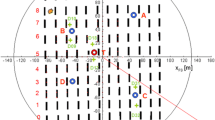Abstract
The Regional Atmospheric Modeling System (RAMS) and the computational fluid dynamics (CFD) codes known as FLUENT are combinatorially applied in a multi-scale numerical simulation of the urban surface layer (USL). RAMS and FLUENT are combined as a multi-scale numerical modeling system, in which the RAMS simulated data are delivered to the computational model for FLUENT simulation in an offline way. Numerical simulations are performed to present and preliminarily validate the capability of the multi-scale modeling system, and the results show that the modeling system can reasonably provide information on the meteorological elements in an urban area from the urban scale to the city-block scale, especially the details of the turbulent flows within the USL.
Similar content being viewed by others
References
Cai, X. M., M. Nasrullah, and Y. Huang, 2004: Fumigation of pollutants into a growing convective boundary layer over an inhomogeneous surface: A large eddy simulation. Atmos. Environ., 38, 3605–3616.
Chandrasekar, A., C. R. Philbrick, B. Doddridge, R. Clark, and P. Georgopoulos, 2003: A comparison study of RAMS simulations with aircraft, wind profiler, lidar, tethered balloon and RASS data over Philadelphia during a 1999 summer episode. Atmos. Environ., 37, 4973–4984.
Chang, C. H., and R. N. Meroney, 2001: Numerical and physical modeling of bluff body flow and dispersion in urban street canyons. Journal of Wind Engineering and Industrial Aerodynamics, 89, 1325–1334.
Cheng Xueling, and Hu Fei, 2005: Numerical studies on flow fields around buildings in an urban street canyon and cross-road. Adv. Atmos. Sci., 22(2), 290–299.
Cotton, W. R., and Coauthors, 2003: RAMS 2001: Current status and future directions. Meteorology and Atmospheric Physics, 82, 5–29.
Ehrhard, J., I. A. Khatib, C. Winkler, R. Kunz, N. Moussiopoulos, and G. Ernst, 2000: The microscale model MIMO: Development and assessment. Journal of Wind Engineering and Industrial Aerodynamics, 85, 163–176.
Fan, H., and D. V. Sailor, 2005: Modeling the impacts of anthropogenic heating on the urban climate of Philadelphia: A comparison of implementations in two PBL schemes. Atmos. Environ., 39(1), 73–84.
Fang Xiaoyi, and Coauthors, 2004: The multi-scale numerical modeling system for research on the relationship between urban planning and meteorological environment. Adv. Atmos. Sci., 21(1), 103–112.
Ferreira, A. D., A. C. Sousa, and D. X. Viegas, 2002: Prediction of building interference effects on pedestrian level comfort. Journal of Wind Engineering and Industrial Aerodynamics, 90, 305–319.
Gosman, A. D., 1999: Developments in CFD for industrial and environmental applications in wind engineering. Journal of Wind Engineering and Industrial Aerodynamics, 81, 21–39.
Hu Xiaoming, Liu Shuhua, Wang Yingchun, and Li Ju, 2005: Numerical simulation of wind and temperature fields over Beijing area in summer. Acta Meteorologica Sinica, 19, 120–127.
Ichinose, T., K. Shimodozono, and K. Hanaki, 1999: Impact of anthropogenic heat on urban climate in Tokyo. Atmos. Environ., 33, 3897–3909.
Li Lei, 2005: A study of multi-scale numerical simulation on urban boundary layer. Ph. D dissertation, Institute of Atmospheric Physics, Beijing. 108pp. (in Chinese)
Li Lei, Hu Fei, Cheng Xueling, and Han Haoyu, 2004: The application of computational fluid dynamics to pedestrian level wind safety problem induced by high-rise buildings. Chinese Physics, 13(7), 1070–1075.
Liu Huizhi, Sang Jianguo, Zhang Boyin, J. C. L. Chan, A. Y. S. Cheng, and Liu Heping, 2002: Influences of structures on urban ventilation: a numerical experiment. Adv. Atmos. Sci., 19(6), 1045–1054.
Miao Shiguang, and Jiang Weimei, 2004: Large eddy simulation and study of the urban boundary layer. Adv. Atmos. Sci., 21(4), 650–661.
Murakami, S., R. Ooka, A. Mochida, S. Yoshida, and S. Kim, 1999: CFD analysis of wind climate from human scale to urban scale. Journal of Wind Engineering and Industrial Aerodynamics, 81, 57–81.
Robertson, L., J. Langner, and M. Engardt, 1999: An Eulerian limited-area atmospheric transport model. J. Appl. Meteor., 38, 190–210.
Roth, M., 2000: Review of atmospheric turbulence over cities. Quart. J. Roy. Meteor. Soc., 126, 941–990.
Sang Jianguo, Liu Heping, Liu Huizhi, and Zhang Zhikang, 2000: Observational and numerical studies of wintertime urban boundary layer. Journal of Wind Engineering and Industrial Aerodynamics, 87, 243–258.
Shih, T. H., W. W. Liou, A. Shabbir, and J. A. Zhu, 1995: A new k-ɛ eddy-viscosity model for high Reynolds number turbulent flows: Model development and validation. Computers & Fluids, 24(3), 227–238.
Walko, R. L., and C. J. Tremback, 2001: RAMS: The regional atmospheric modeling system, Version 4.3/4.4, Introduction to RAMS 4.3/4.4. ASTER Division. Mission Research Corporation, Fort Collins, CO., 10pp.
Yang Yuhua, Xu Xiangde, and Weng Yonghui, 2003: Simulation of daily cycle of boundary layer heat island in Beijing. Journal Applied Meteorological Sciences, 14(1), 61–68. (in Chinese)
Zhang Meigen, Xu Yongfu, I. Uno, and H. Akimoto, 2004: A numerical study of tropospheric ozone in the springtime in East Asia. Adv. Atmos. Sci., 21(2), 163–170.
Author information
Authors and Affiliations
Rights and permissions
About this article
Cite this article
Li, L., Hu, F., Jiang, J. et al. An application of the RAMS/FLUENT system on the multi-scale numerical simulation of the urban surface layer—A preliminary study. Adv. Atmos. Sci. 24, 271–280 (2007). https://doi.org/10.1007/s00376-007-0271-y
Received:
Revised:
Issue Date:
DOI: https://doi.org/10.1007/s00376-007-0271-y




